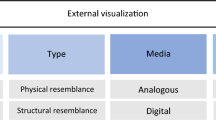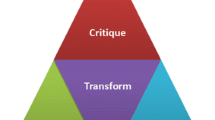Abstract
The significance of the role of students’ interpretation and creation of multiple forms of representation in science learning has long been established and advocated, but there is a paucity of research into the extent to which this emphasis in science education is reflected in high stakes final year high school science examinations. This study investigated the inclusion of visualizations in the questions within such examinations that require students to construct a response, and also the extent to which such questions required students to create or modify diagrams or graphs within their responses. Examinations in physics, biology and chemistry from the Cambridge International Examination, New Zealand, Singapore and the States of New South Wales and Victoria in Australia over a six-year period (2014-2019) were analysed. The results indicate that less than one third of constructed response item (CRI) questions include visualisations, with most occurring in physics, then biology and then chemistry. An infinitesimally small percentage of questions across all subjects and in all but one of the jurisdictions required the creation or augmentation of visualisations. The misalignment between the integral role of visualizations in science pedagogy and the paucity of visualizations in CRIs in final year high school examinations as well as implications for examination re-design and associated further research are discussed.













Similar content being viewed by others
References
Airey, J., & Linder, C. (2009). A disciplinary discourse perspective on university science learning: Achieving fluency in a critical constellation of modes. Journal of Research in Science Teaching, 46(1), 27–49.
Airey, J., & Linder, C. (2017). Social semiotics in university physics education. In D. Treagust, R. Duit, & H. Fischer (Eds.), Multiple representations in physics education (pp. 95–122). Springer.
Carter, C. N. (2020). How a high-stakes standardized biology assessment affects teachers' pedagogical planning and implementation for minority students of low socioeconomic status (Doctoral dissertation, Cabrini University).
Chang, H.-Y., Lin, T.-J., Lee, M.-H., Lee, S.W.-Y., Lin, T.-C., Tan, A.-L., & Tsai, C.-C. (2020). A systematic review of trends and findings in research employing drawing assessment in science education. Studies in Science Education, 56(1), 77–110. https://doi.org/10.1080/03057267.2020.1735822
Cheng, M. M., & Gilbert, J. K. (2015). Students’ Visualization of Diagrams Representing the Human Circulatory System: The use of spatial isomorphism and representational conventions. International Journal of Science Education, 37(1), 136–161. https://doi.org/10.1080/09500693.2014.969359
Eilam, B., & Gilbert, J. K. (Eds). (2014). Science teachers’ use of visual representations (Vol. 8). Springer. https://doi.org/10.1007/978-3-319-06526-7
English, J. (2020). Animation in online school science assessment: The validation of assessment for learning and individual development program. In L. Unsworth (Ed.), Learning from Animations in Science Education: Innovating in Semiotic and Educational Research (pp. 251–277). Springer, Cham. https://doi.org/10.1007/978-3-030-56047-8
Erduran, S., El Masri, Y., Cullinane, A., & Ng, Y. (2020). Assessment of practical science in high stakes examinations: A qualitative analysis of high performing English-speaking countries. International Journal of Science Education, 42(9), 1544–1567. https://doi.org/10.1080/09500693.2020.1769876
Fiorella, L., & Zhang, Q. (2018). Drawing boundary conditions for learning by drawing. Educational Psychology Review, 30(3), 1115–1137. https://doi.org/10.1007/s10648-018-9444-8
Fuhrmann, T., Schneider, B., & Blikstein, P. (2018). Should students design or interact with models? Using the Bifocal Modelling Framework to investigate model construction in high school science. International Journal of Science Education, 40(8), 867–893. https://doi.org/10.1080/09500693.2018.1453175
Gilbert, J. K. (2005). Visualization: A metacognitive skill in science and science education. In J. K. Gilbert (Ed.), Visualization in Science Education (pp. 9–27). Springer.
Gilbert, J. K., & Treagust, D. (2009). Multiple representations in chemical education (Vol. 4). Springer. https://doi.org/10.1007/978-1-4020-8872-8
Gilbert, J. K., Reiner, M., & Nakhleh, M. (Eds.). (2008). Visualization: Theory and practice in science education (1st ed.). Springer Netherlands. https://doi.org/10.1007/978-1-4020-5267-5
Gooding, D. (2004). Visualization, inference and explanation in the sciences. In G. Malcolm (Ed.), Studies in multidisciplinarity (Vol. 2, pp. 1–25). Elsevier.
Gooding, D. (2006). From Phenomenology to Field Theory: Faraday’s Visual Reasoning. Perspectives on Science, 14(1), 40–65. https://doi.org/10.1162/posc.2006.14.1.40
Gray, K. E., Wittmann, M. C., Vokos, S., & Scherr, R. E. (2019). Drawings of energy: Evidence of the Next Generation Science Standards model of energy in diagrams. Physical Review Physics Education Research, 15(1), 010129. https://doi.org/10.1103/PhysRevPhysEducRes.15.010129
Hand, B., McDermott, M., & Prain, V. (Eds.). (2016). Using Multimodal Representations to Support Learning in the Science Classroom. Springer. https://doi.org/10.1007/978-3-319-16450-2.
Hart, C. (2001). Examining relations of power in a process of curriculum change: The case of VCE physics. Research in Science Education, 31(4), 525–551.
Hart, C. (2002). Framing curriculum discursively: Theoretical perspectives on the experience of VCE physics. International Journal of Science Education, 24(10), 1055–1077. https://doi.org/10.1080/09500690110098930
Hubber, P., & Tytler, R. (2017). Enacting a representation construction approach to teaching and learning astronomy. In D. Treagust, R. Duit, & H. Fischer (Eds.), Multiple Representations in Physics Education (pp. 139–161). Springer. https://doi.org/10.1007/978-3-319-58914-5.
Johnston, M., Wood, B. E., Cherrington, S., Boniface, S., & Mortlock, A. (2022). Representations of Disciplinary Knowledge in Assessment: Associations between High School and University Assessments in Science, Mathematics and the Humanities and Predictors of Success. Educational Assessment, 1–21.
Klein, U. (2001). Introduction. In U. Klein (Ed.), Tools and modes of representation in the laboratory sciences. Kluwer Academic Publishers.
Kragten, M., Admiraal, W., & Rijlaarsdam, G. (2015). Students’ learning activities while studying biological process diagrams. International Journal of Science Education, 37(12), 1915–1937. https://doi.org/10.1080/09500693.2015.1057775
LaDue, N. D., Libarkin, J. C., & Thomas, S. R. (2015). Visual representations on high school biology, chemistry, earth science, and physics assessments. Journal of Science Education and Technology, 24(6), 818–834. https://doi.org/10.1007/s10956-015-9566-4
Latour, B., & Woolgar, S. (1979). Laboratory life: The construction of scientific facts. Princeton University Press.
Liu, X., & Fulmer, G. (2008). Alignment between the science curriculum and assessment in selected NY state regents exams. Journal of Science Education and Technology, 17(4), 373–383. https://doi.org/10.1007/s10956-008-9107-5
Machová, M. (2021). Phylogenetic trees and other evolutionary diagrams in biology textbooks and their importance in secondary science education. Scientia in Educatione, 12(1), 16–36.
McDermott, M. A., & Hand, B. (2013). The impact of embedding multiple modes of representation within writing tasks on high school students’ chemistry understanding. Instructional Science, 41(1), 217–246. https://doi.org/10.1007/s11251-012-9225-6
McDermott, M. A., & Hand, B. (2016). Modeling scientific communication with multimodal writing tasks: Impact on students at different grade levels. In B. Hand, M. McDermott, & V. Prain (Eds.), Using multimodal representations to support learning in the science classroom (pp. 183–211). Springer. https://doi.org/10.1007/978-3-319-16450-2_10
McLure, F., Won, M., & Treagust, D. F. (2021). What students’ diagrams reveal about their sense-making of plate tectonics in lower secondary science. International Journal of Science Education, 43(16), 2684–2705. https://doi.org/10.1080/09500693.2021.1983922
McLure, F., Won, M., & Treagust, D. F. (2022). Analysis of Students’ Diagrams Explaining Scientific Phenomena. Research in Science Education, 52, 1225–1241. https://doi.org/10.1007/s11165-021-10004-y
Miller, B., Cromley, J., & Newcombe, N. S. (2016). Improving diagrammatic reasoning in middle school science using conventions of diagrams instruction. Journal of Computer Assisted Learning, 32(4), 374–390. https://doi.org/10.1002/sce.21241
Nersessian, N. (2008). Model-based reasoning in scientific practice. In R. Duschl & R. Grandy (Eds.), Teaching scientific inquiry: Recommendations for research and implementation (pp. 57–79). Sense.
NGSS Lead States. (2013). Next Generation Science Standards: For States. National Academies Press.
Organisation for Economic Co-operation and Development. (2019). PISA 2018 assessment and analytical framework. OECD publishing. https://doi.org/10.1787/b25efab8-en
Parodi, G. (2012). University genres and multisemiotic features: Accessing specialized knowledge through disciplinarity. Fórum Linguıstico, 9(4), 259–282.
Prain, V., & Tytler, R. (2012). Learning through constructing representations in science: A framework of representational construction affordances. International Journal of Science Education, 34(17), 2751–2773.
Prain, V., & Tytler, R. (2022). Theorising Learning in Science Through Integrating Multimodal Representations. Research in Science Education, 52(3), 805–817. https://doi.org/10.1007/s11165-021-10025-7
Prain, V., Tytler, R., & Peterson, S. (2009). Multiple representation in learning about evaporation. International Journal of Science Education, 31(6), 787–808. https://doi.org/10.1080/09500690701824249
Tang, K. S. (2020). Discourse strategies for science teaching and learning: Research and practice. Routledge.
Tang, K.-S., Won, M., & Treagust, D. (2019). Analytical framework for student-generated drawings. International Journal of Science Education, 41(16), 2296–2322. https://doi.org/10.1080/09500693.2019.1672906
Tippett, C. D. (2016). What recent research on diagrams suggests about learning with rather than learning from visual representations in science. International Journal of Science Education, 38(5), 725–746. https://doi.org/10.1080/09500693.2016.1158435
Treagust, D. F., Duit, R., & Fischer, H. E. (Eds.). (2017). Multiple representations in physics education (Vol. 10). Springer International Publishing. https://doi.org/10.1007/978-3-319-58914-5
Treagust, D. F., & Tsui, C.-Y. (2013). Multiple representations in biological education. Springer Science & Business Media. https://doi.org/10.1007/978-94-007-4192-8
Tytler, R., Prain, V., Aranda, G., Ferguson, J., & Gorur, R. (2020). Drawing to reason and learn in science. Journal of Research in Science Teaching, 57(2), 209–231. https://doi.org/10.1002/tea.21590
Tytler, R., Prain, V., & Hubber, P. (2018). Representation Construction as a Core Science Disciplinary Literacy. In K.-S. Tang & K. Danielsson (Eds.), Global Developments in Literacy Research for Science Education (pp. 301–318). Springer. https://doi.org/10.1007/978-3-319-69197-8
Tytler, R., Prain, V., Hubber, P., & Waldrip, B. (2013). Constructing representations to learn in science. Springer Science & Business Media.
Van Rooy, W. S., & Chan, E. (2017). Multimodal representations in senior biology assessments: A case study of NSW Australia. International Journal of Science and Mathematics Education, 15(7), 1237–1256.
Vogler, K. E., & Carnes, G. N. (2014). Comparing the Impact of a High School Exit Examination on Science Teachers’ Instructional Practices. Journal of Curriculum and Instruction, 8(2), 36–67.
Funding
This research was supported by an Australian Research Council Linkage Projects grant (LP160100263) funded by the Australian Government. The views expressed herein are those of the authors and are not necessarily those of the Australian Research Council.
Author information
Authors and Affiliations
Corresponding author
Ethics declarations
Conflict of Interest
The authors declare no competing interests.
Additional information
Publisher's Note
Springer Nature remains neutral with regard to jurisdictional claims in published maps and institutional affiliations.
Rights and permissions
Springer Nature or its licensor (e.g. a society or other partner) holds exclusive rights to this article under a publishing agreement with the author(s) or other rightsholder(s); author self-archiving of the accepted manuscript version of this article is solely governed by the terms of such publishing agreement and applicable law.
About this article
Cite this article
Unsworth, L., Herrington, M. Visualization Type and Frequency in Final Year High School Science Examinations. Res Sci Educ 53, 707–725 (2023). https://doi.org/10.1007/s11165-022-10094-2
Accepted:
Published:
Issue Date:
DOI: https://doi.org/10.1007/s11165-022-10094-2




